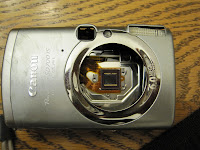I learned that one thing I’m not good at is repairing modern electronics as compact and as complicated as a digital camera.
I could probably handle swapping out the LCD for an equivalent one (but beware that each model uses a slightly different one, even in the same line from the same manufacturer). Unfortunately, my most recent two problems involved the lens. The one that went into the pool a few years ago doesn’t count as a repair candidate (although see my post on waterproof containers here for how to keep your camera safe).
On many (if not most) digital cameras, the lens automatically extends when you turn it on. If that lens gets jammed, the camera is very unhappy.
First repair attempt
A while ago my Canon SD700IS somehow managed to open itself in the camera case, causing it to jam. When powering it on or off, it would try to open or close the lens, but give up after a few moments stating “Lens error, restart camera”. Not too helpful, as restarting repeats the process. I found information online, and thought I could disassemble it and repair the physical problem with the lens. It did NOT go so well. After many steps unwrapping this complicated beast, I realized that I would never get it back together. The lens mechanism was at the very center of the camera, and I couldn’t dissasemble it to fix it. So much for that one.
 |
| Here’s an “after” picture. I must have forgotten a piece when reassembling… |
The good news is that I salvaged a few micro-screws to repair a Kodak camera that was falling apart with the panels falling off. I also had some neat parts to inspect and play with – reminds me of when I was a kid and dissasembled things (permanently) to see how they worked. Not very practical though.
This seems familiar…
The next problem camera was with the newest camera, the SD780IS. It’s a fantastic camera – compact, very quick to take pictures, very high resolution (photo and video). Everything went great, until a gust of wind blew it over from where it was perched for a timed photo. It landed on the extended lens mechanism… and I got the same lens message. Deja Vu from the first camera. Frustrating, because it won’t let you use it as a media server if the lens doesn’t work (the camera can connect to a TV, even with an HDMI cable, to show pictures and video).
Knowing the low chances of me successfully fixing it, I sent that camera in to Canon. The online repair form quoted zero dollars to fix it (after I selected what was wrong). Worth a shot even if they really don’t think the warranty covers it, as I’d like to have that camera working again. A few days later I got the notice that they received the camera. The revised estimate was $129.88. What? That’s almost the price of a new one (curently $168 on Amazon). For an extra $40, I’d prefer having a new one – with new cables, battery, etc. I think they’re trying to be clear – they don’t want to see these things again after they leave the factory. They’re disposable, and it’s time to buy a new one.
Well yes, I’m going to buy the same one again. It was a pretty sweet little camera, and performs so much better than my SD1200IS (which is still great, except by comparison). I’ve been checking around, and I don’t ususally find it cheaper than on Amazon. Check here for the latest price on the SD780IS.
 |
| It’s sleek, fast, and will soon be mine again. |
In summary, while there are thousands of pages with info on fixing various camera models, it might be a better investment to just buy a new one. Cameras are a tool, and tools get damaged when you use them. Better than having a tool in perfect condition because you never used it for the purpose you bought it for, right?
